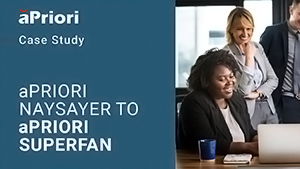Collaborative Manufacturing is the New Frontier of Digital Transformation
Leach Archibald: So tell me a little bit about your decision-making around aPriori. Where are you in your journey of digital transformation?
Don Stamens: My journey with aPriori started about 14 years ago, and I voted against implementing this new product.
LA: Oh no. Why?
DS: I tried to not have aPriori added to our business processes, because at the time I didn’t see the functionality. But the product development I was shown this morning is absolutely world-class. It’s so needed in the manufacturing industry today. As the quality of both teaching engineers and also procurement people continues to degrade worldwide, we need this type of automation. Today many engineers come out and they don’t know how to do product design in a way that matches the manufacturing process and satisfies the user experience. Procurement people don’t know how to have a fact-based negotiation. aPriori creates a common language with shared metrics so that stakeholders can have these kind of discussions. And they can use this information for supply chain collaboration, to create fact-based negotiations that get to Should Cost rather than Does Cost.
LA: Explain Does Cost Model versus Should Cost Model.
DS: Does Cost Model is when people don’t know much about manufacturing processes and they want a magic bullet for profitability. So they drop a CAD model in and say, “Well, Mr. Supplier, this is what it has to cost.” They go out and use that as a club on suppliers. It’s very, very destructive to partnerships. And now with the supply chain challenges, if you don’t have a positive partnership, honestly suppliers are walking away from you. The contract manufacturers have material constraints are very real. And if you keep on going for the year-over-year cost reduction with no real design initiatives to help, you will lose your partnerships and your competitive advantage. On the other hand, if you use aPriori to create a design language that you can translate into manufacturing execution systems, the contract manufacturers can say, “Okay, yes, this makes sense.” I do not need to accept all price reduction demands, but I understand for this part I can have the price go down if I switch manufacturing processes. Versus: give me 3% or give me 5%.
LA: In this particular recessionary moment, you’re just running out of your ability to squeeze.
DS: Right. Because it’s like, if I squeeze anymore, manufacturing operations might as well shut down. So that’s where collaborative manufacturing comes in — having that design language and that ability to have a fact-based conversation is so important.
